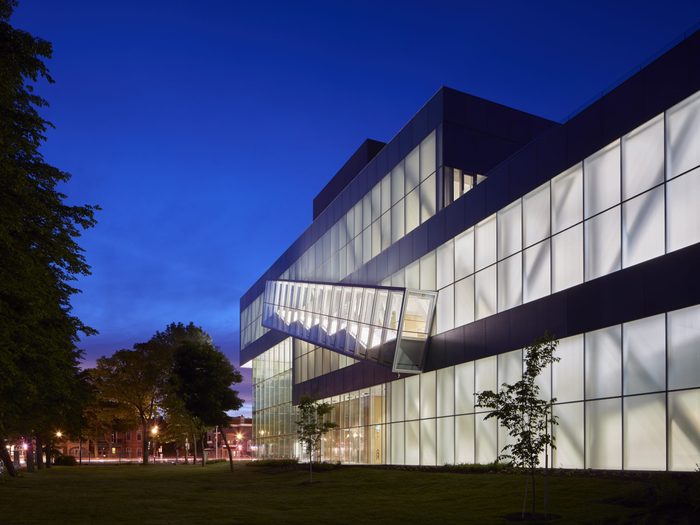
The Pierre Lassonde Pavilion
Facing Québec City artery Grande-Allée, the Pierre Lassonde Pavilion is a piece of art in itself. Made almost entirely of glass and steel, it creates an inside-out illusion and allows natural light to enter its seven exhibition spaces. Built in 2016, it is the latest addition to the Musée National des Beaux-Arts du Québec’s four buildings. Highlights include the Canam Group suspended staircase, which protrudes from the building and looks onto National Battlefield Park, giving the impression of walking on air.
Discover the history behind Montreal’s diverse neighbourhoods.
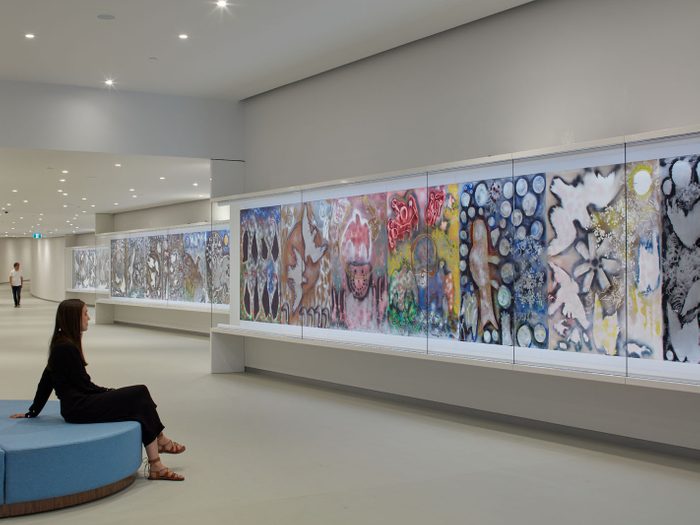
Jean-Paul Riopelle’s Tribute to Rosa Luxemburg
With the space gained from the addition of the Pierre Lassonde Pavilion, museum guests can now enjoy Tribute to Rosa Luxemburg in its full glory. The 40 metre-long spray-paint piece consists of 30 tableaux depicting animal silhouettes surrounded by everyday objects. This must-see is located in the passageway connecting the Pavilion to the rest of the Musée National des Beaux-Arts du Québec’s complex.
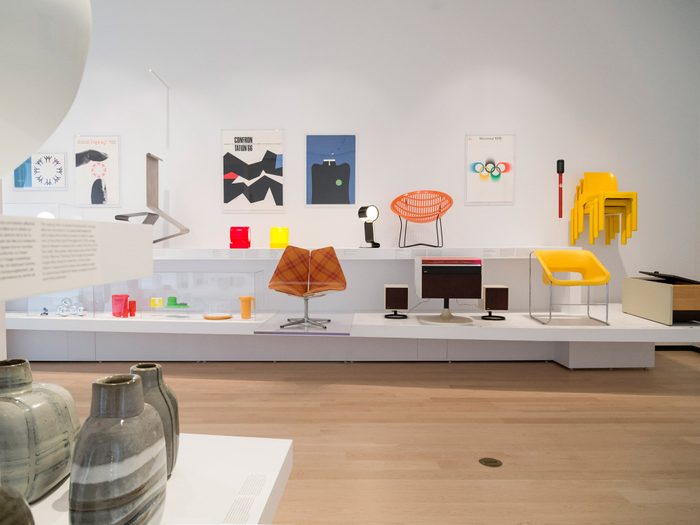
Decorative Arts and Design in Québec
Boasting 180 pieces from more than 100 artists, the Decorative Arts and Design exposition showcases Quebecois design from the 1950s to present day. From decorative ceramic artware and furniture to graphic design, this exhibit brings the beauty of everyday objects to the fore. Highlights include graphic design from Expo ’67 and furniture created for Montreal’s Olympic Park—both representing significant milestones in the province’s recent history.
Do you know the intriguing history of Quebec’s log homes?
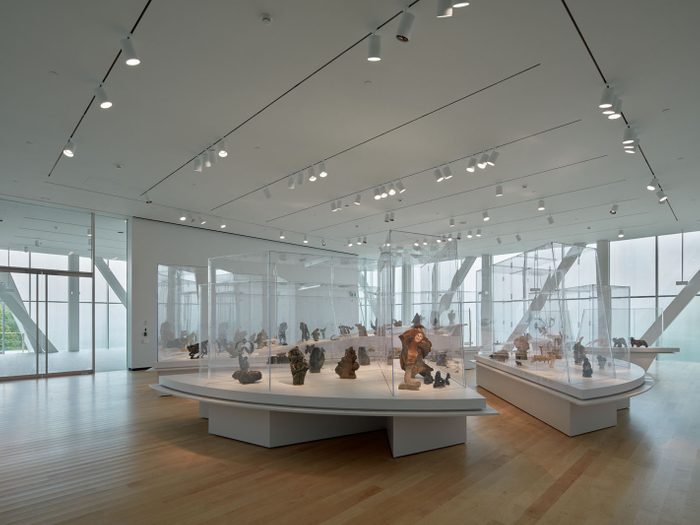
Inuit Art: The Ilippunga Collection
The Ilippunga exhibit features 100 pieces of Inuit artwork from the last 60 years. Inspired by the northern landscape, the exhibition space in the Pierre Lassonde Pavilion was specifically chosen for its northern exposure. The collection respects seven themes that reflect values important to the Inuit themselves—respect for animals and land, caring for each other, oral histories of the Arctic, the importance of family and respect for mothers, Shamans and traditional Inuit spirituality, changes in the Arctic in the 20th century and cultural resurgence through the arts. Highlights include Manasie Akpaliapik’s Motherhood—made from whalebone and depicting the stages of a child’s conception and birth.
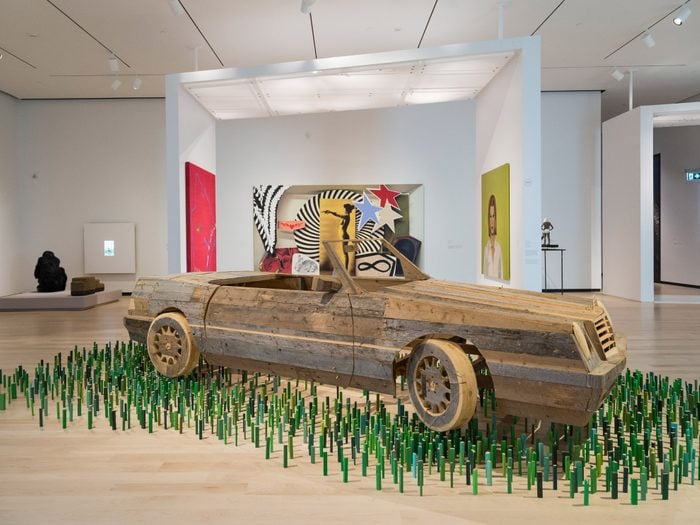
Contemporary Art in Québec
Bursting with colour and creativity, the Musée National des Beaux-Arts du Québec’s Contemporary Art in Québec exhibit showcases more than 9,000 works from some of Québec’s most prominent artists. The collection consists of paintings, sculptures, photography and video reflecting the socio-cultural and political changes brought on by the Quiet Revolution in the 1960s. With abstraction, more importance was placed on the creative process than the final product, so styles that typically wouldn’t fit together are displayed side-by-side to reflect the diversity of the 20th century’s artistic approach. Among the envelope-pushing works on display is Perdu dans la nature (above), a collaborative installation by Nicolas Laverdière, Sébastien Giguère, Jasmin Bilodeau and BGL.
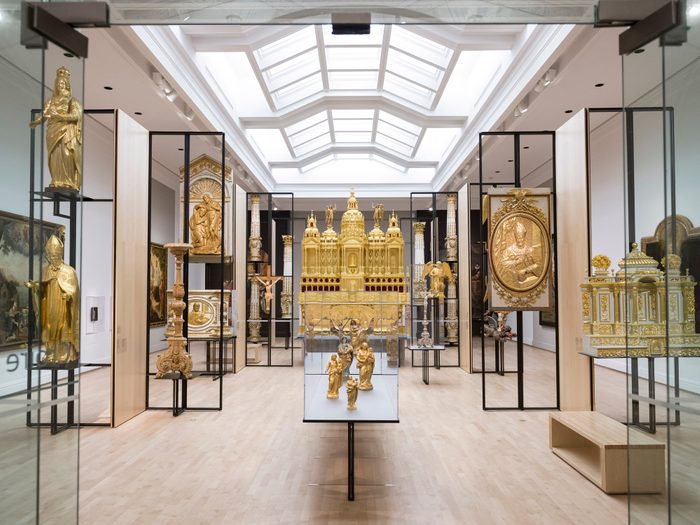
Believing, 350 Years of Art Practice in Québec
When the first French settlers arrived in Quebec, they brought with them works of art intended for trade. Largely religious in nature, these 17th century treasures inspired the colony’s artists to develop their own sculpture, embroidery and original works in gold and silver. A large number of these early pieces are on display in the Musée National des Beaux-Arts du Québec’s Believing exhibit.
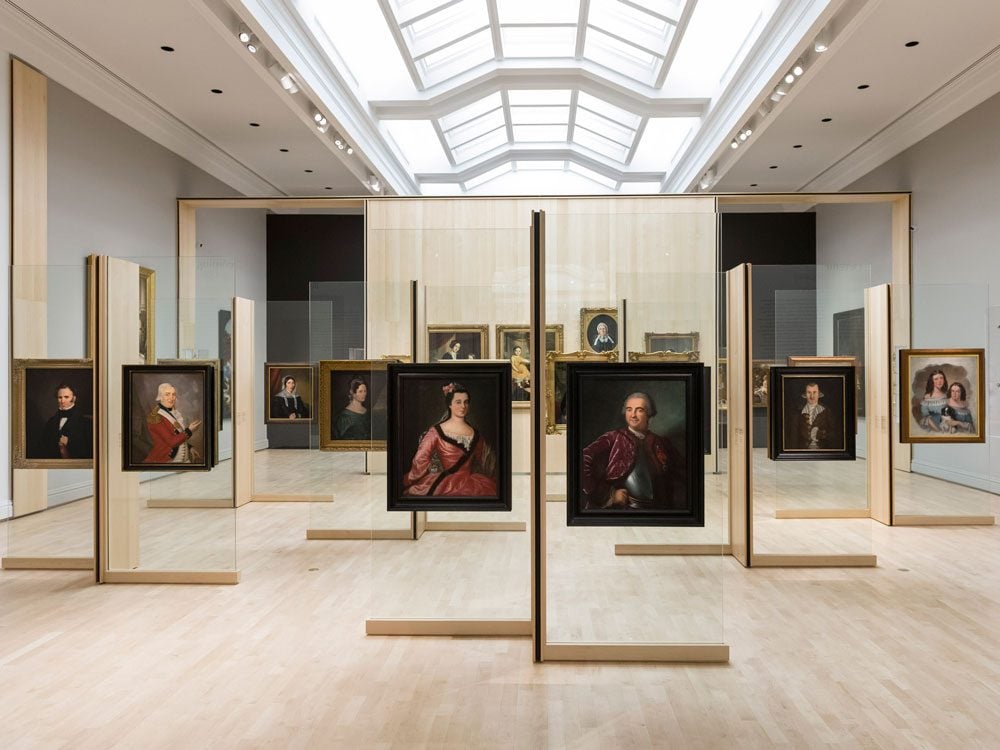
Becoming, 350 Years of Art Practice in Québec
This collection of late 18th century art showcases portraits of the movers and shakers of that period, captured by artists from across Quebec, Europe, and the United States. Highlights include the cherubic paintings of Madame Gaspard-Joseph Chaussegros de Léry and Gaspard-Joseph Chaussegros de Léry by an unknown artist (in foreground, above).
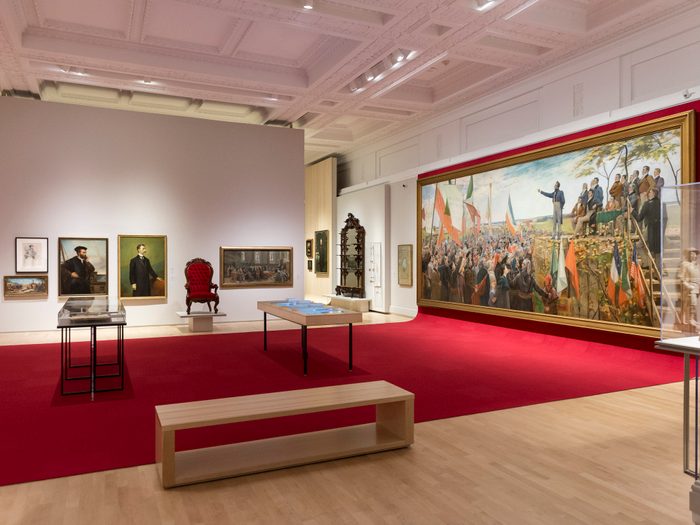
Charles Alexander’s L’Assemblée des six comtés à Saint-Charles-sur-Richelieu, en 1837
Measuring nearly 10 feet high and more than 22 feet long, Charles Alexander’s monumental L’Assemblée des six comtés à Saint-Charles-sur-Richelieu, en 1837 is a must-see in the Musée National Des Beaux-Arts du Quebec. A prelude to the Patriots’ War, the Assembly of the Six Counties depicted in the painting is one of the most significant moments in Quebec’s history. Alexander’s sprawling canvas is the showstopper in the museum’s Imagining gallery, which explores the ways in which artists depict historical events without having witnessed them firsthand.
Don’t miss out on these incredible places to spend the night in Quebec.
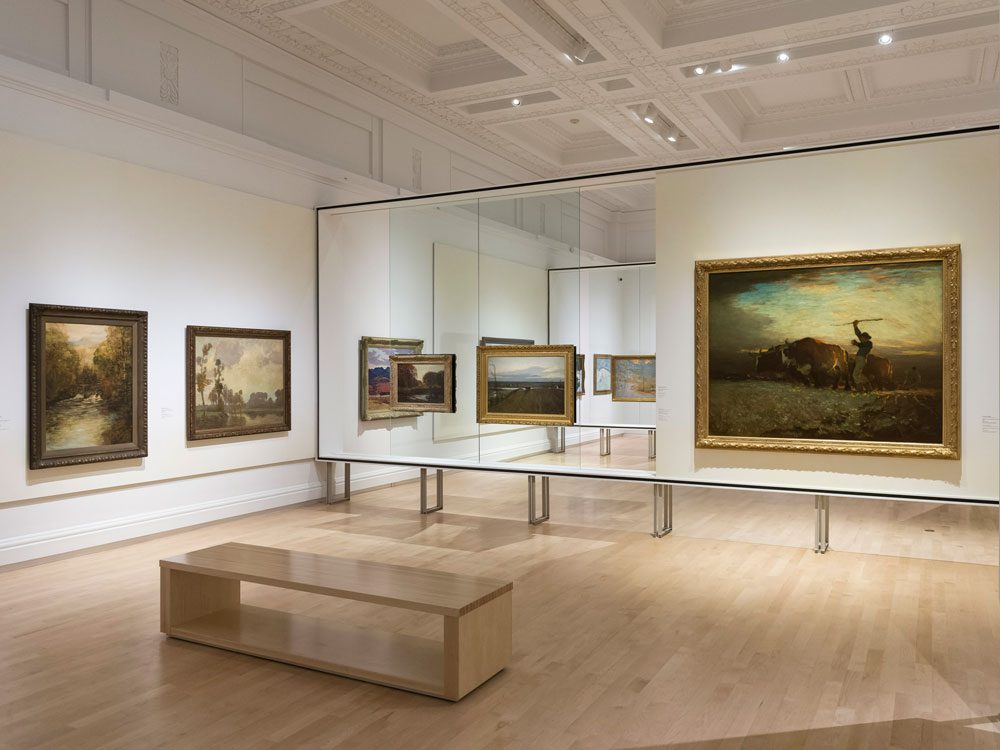
Horatio Walker’s Labour aux premières lueurs du jour
Horatio Walker’s masterly 1900 work Labour aux premières lueurs du jour (above, right) highlights the values and struggles of early Canadian settlers. Garnering accolades and earning Walker the nickname “the American Millet,”—a flattering allusion to famous French rural painter Jean-Francois Millet—the painting depicts farmers working the land on Île d’Orléans in rural Quebec. The piece is part of the Feeling, 350 Years of Art Practice in Quebec exhibit, which celebrates Canadian panoramas throughout the seasons, with a particular focus on Quebec’s stunning scenery. Landscape painting and photography gained much popularity among art critics and public in the 1880s and 1900s. As artists moved away from traditional styles, romantic, impressionist and post-impressionist landscapes emerged.
Check out these reasons to visit Quebec in the winter.
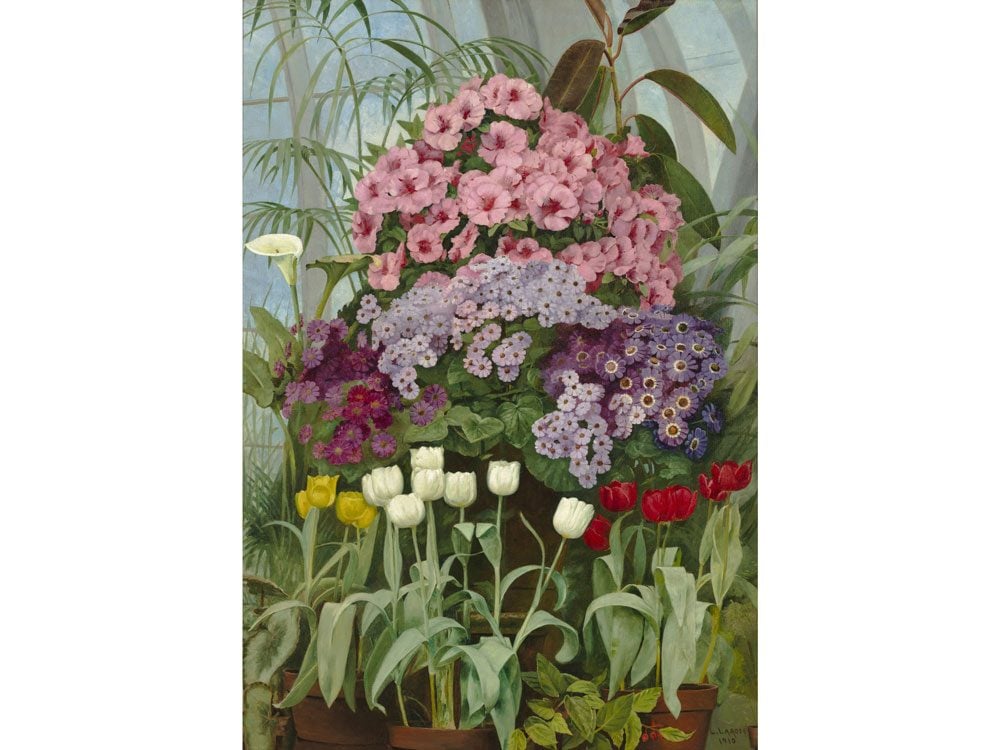
Ludger Larose’s La Serre
Ludger Larose’s La Serre was a game-changer for Québecois art in the 20th century. Rather than the traditional still life portraying cut flowers in a vase, Larose opted to paint potted plants in a greenhouse. The use of vivid colours and its bold composition make it unique. Visitors to the Musée National des Beaux-Arts du Québec can find this piece on display in the Challenging, 350 Years of Art Practice in Québec exhibit, which showcases works from the first half of the 20th century.
Planning a weekend in the City of Festivals? Here are the best things to do in Montreal.